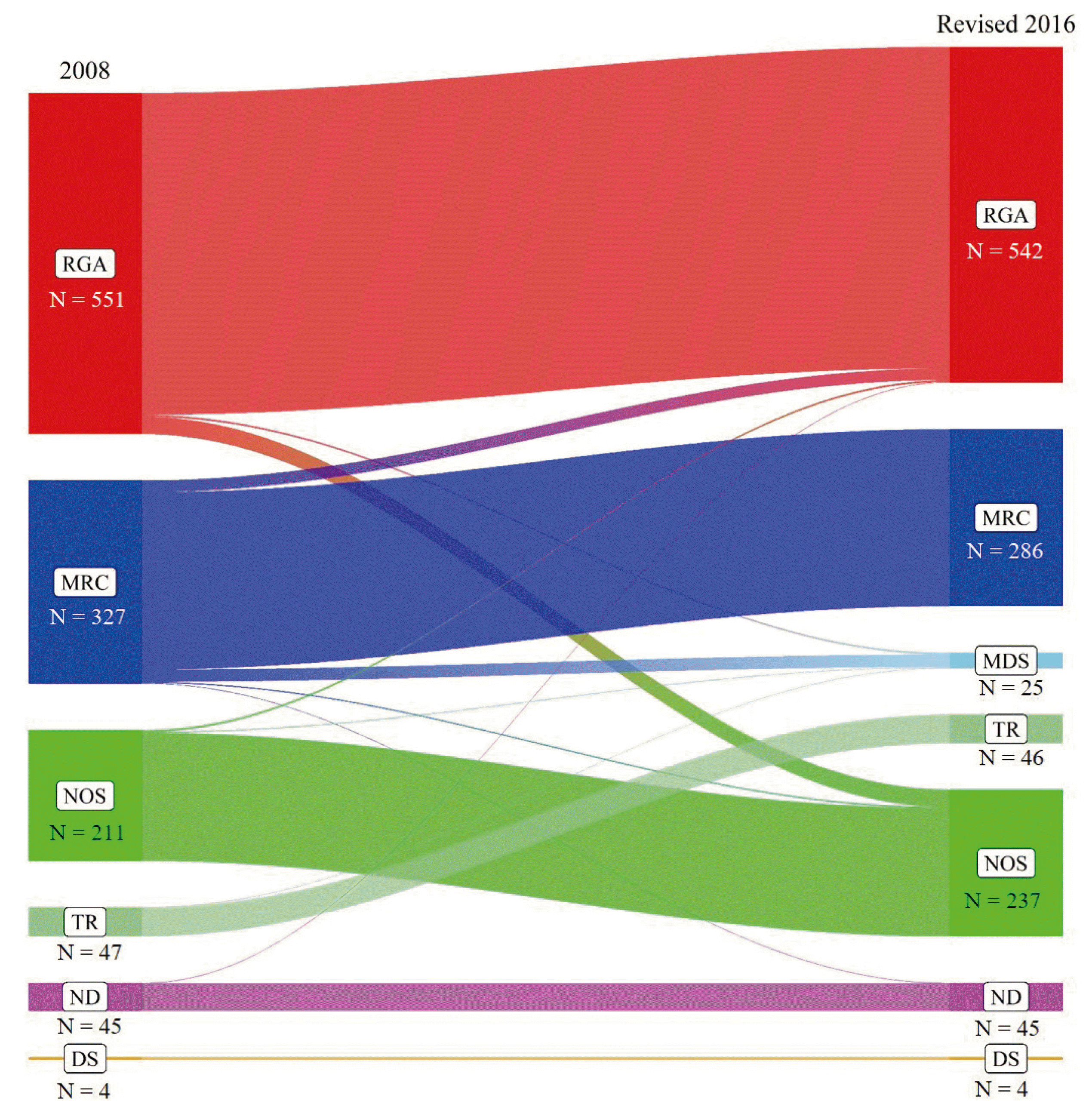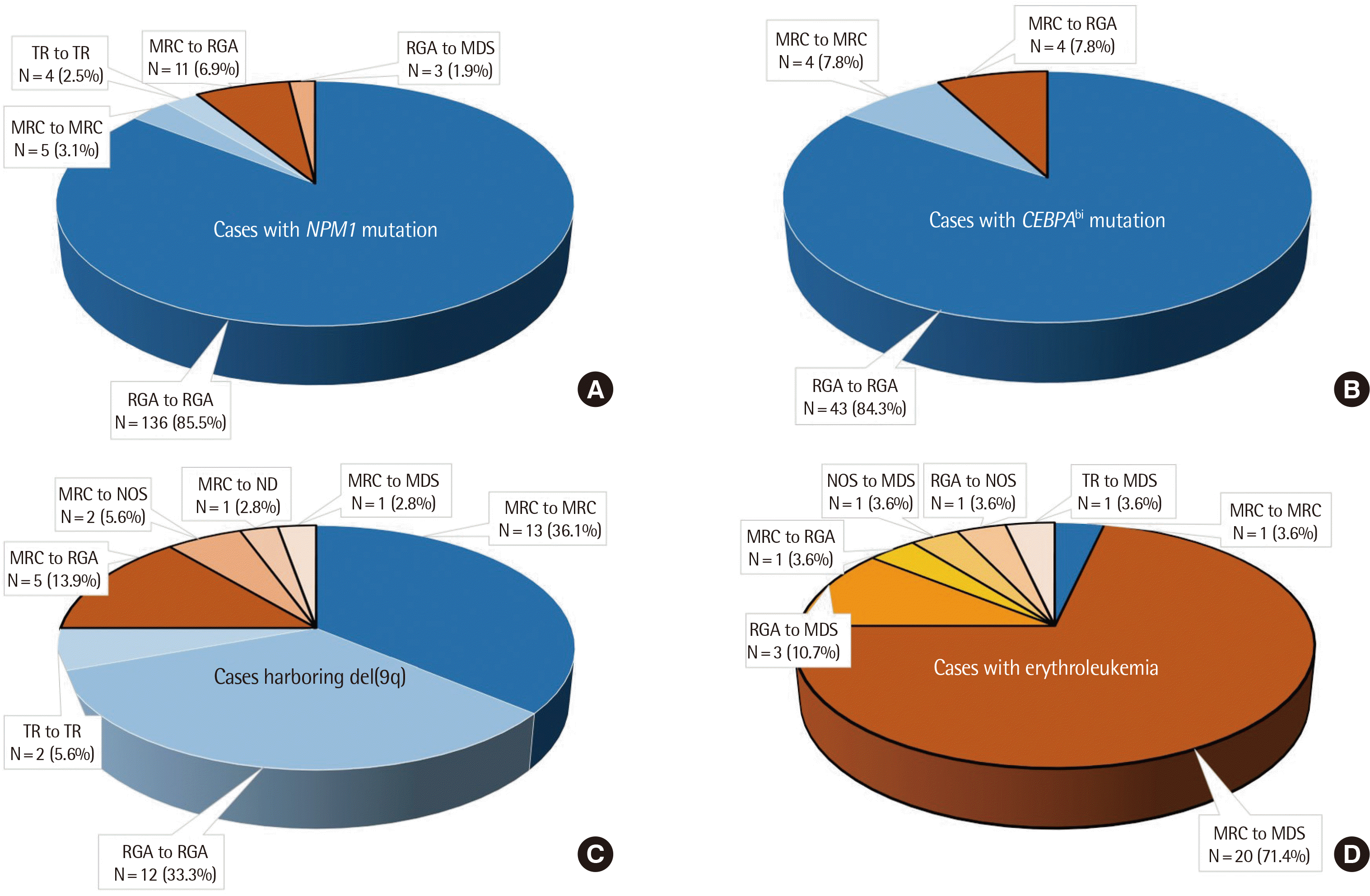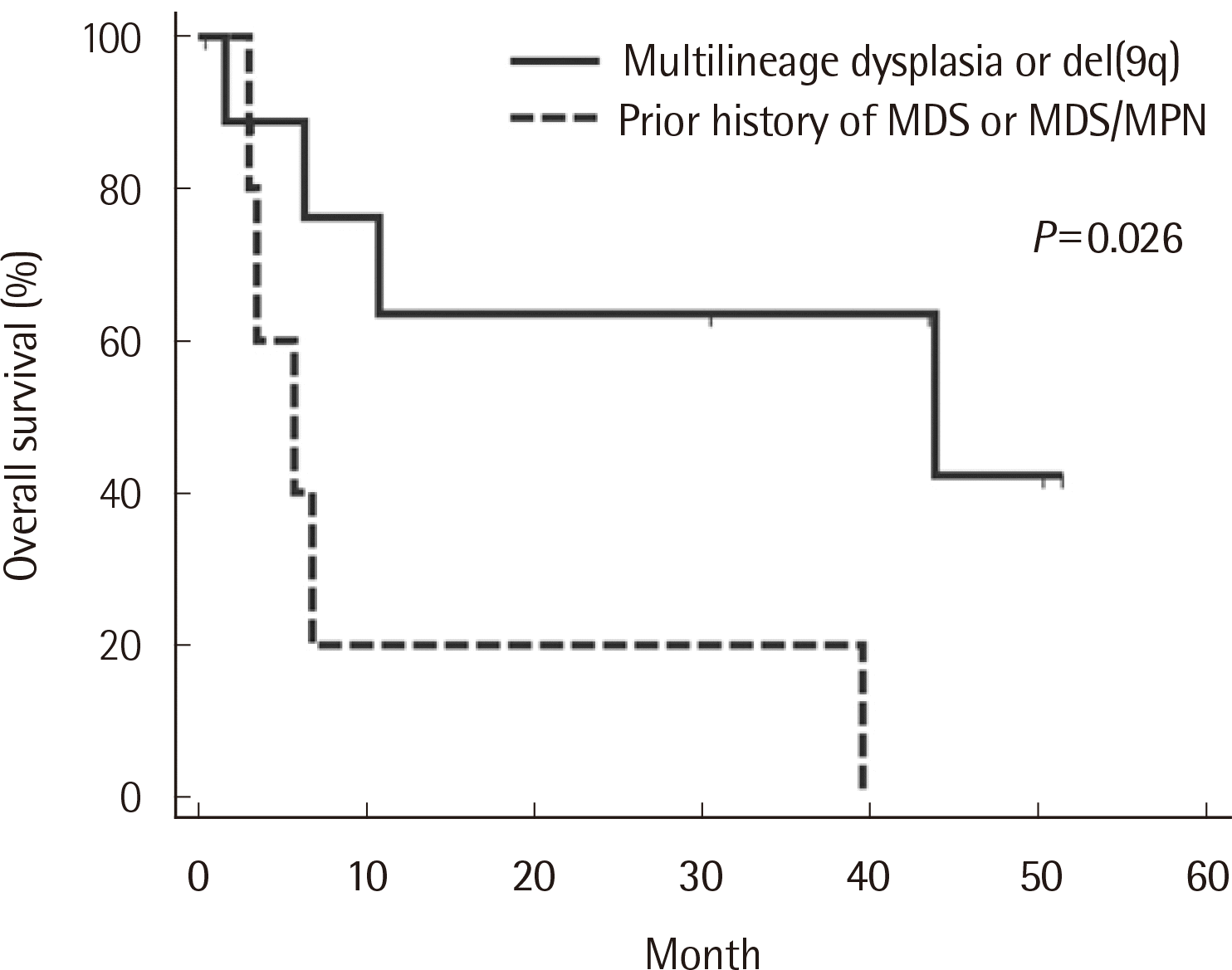1. Swerdlow SH, Campo E, editors. 2017. WHO classification of tumours of haematopoietic and lymphoid tissues. Revised 4th ed. International Agency for Research on Cancer;Lyon, France: p. 129–71.
2. Leonard JP, Martin P, Roboz GJ. 2017; Practical implications of the 2016 revision of the World Health Organization classification of lymphoid and myeloid neoplasms and acute leukemia. J Clin Oncol. 35:2708–15. DOI:
10.1200/JCO.2017.72.6745. PMID:
28654364.


3. Arber DA, Orazi A, Hasserjian R, Thiele J, Borowitz MJ, Le Beau MM, et al. 2016; The 2016 revision to the World Health Organization classification of myeloid neoplasms and acute leukemia. Blood. 127:2391–405. DOI:
10.1182/blood-2016-03-643544. PMID:
27069254.


4. Chen Y, Pourabdollah M, Atenafu EG, Tierens A, Schimmer A, Chang H. 2017; Re-evaluation of acute erythroid leukemia according to the 2016 WHO classification. Leuk Res. 61:39–43. DOI:
10.1016/j.leukres.2017.08.011. PMID:
28886412.


5. Toth LN, de Abreu FB, Peterson JD, Loo EY. 2018; Impact of molecular sequencing information as related to 2008 and 2016 World Health Organization classification of acute myeloid leukemia and myelodysplasia. Arch Pathol Lab Med. 142:1017. DOI:
10.5858/arpa.2017-0577-LE. PMID:
30141999.

6. Margolskee E, Mikita G, Rea B, Bagg A, Zuo Z, Sun Y, et al. 2018; A reevaluation of erythroid predominance in acute myeloid leukemia using the updated WHO 2016 criteria. Mod Pathol. 31:873–80. DOI:
10.1038/s41379-018-0001-2. PMID:
29403082.


7. Ryu S, Park HS, Kim SM, Im K, Kim JA, Hwang SM, et al. 2018; Shifting of erythroleukemia to myelodysplastic syndrome according to the revised WHO classification: biologic and cytogenetic features of shifted erythroleukemia. Leuk Res. 70:13–9. DOI:
10.1016/j.leukres.2018.04.015. PMID:
29729583.


8. Jung J, Cho BS, Kim HJ, Han E, Jang W, Han K, et al. 2019; Reclassification of acute myeloid leukemia according to the 2016 WHO classification. Ann Lab Med. 39:311–6. DOI:
10.3343/alm.2019.39.3.311. PMID:
30623623. PMCID:
PMC6340847.



9. Kansal R. 2019; Classi cation of acute myeloid leukemia by the revised fourth edition World Health Organization criteria: a retrospective single-institution study with appraisal of the new entities of acute myeloid leukemia with gene mutations in NPM1 and biallelic CEBPA. Hum Pathol. 90:80–96. DOI:
10.1016/j.humpath.2019.04.020. PMID:
31077683.

10. Huang Q, Chen W, Gaal KK, Slovak ML, Stein A, Weiss LM. 2008; A rapid, one step assay for simultaneous detection of
FLT3/ITD and
NPM1 mutations in AML with normal cytogenetics. Br J Haematol. 142:489–92. DOI:
10.1111/j.1365-2141.2008.07205.x. PMID:
18477048.

11. Falini B, Mecucci C, Tiacci E, Alcalay M, Rosati R, Pasqualucci L, et al. 2005; Cytoplasmic nucleophosmin in acute myelogenous leukemia with a normal karyotype. N Engl J Med. 352:254–66. DOI:
10.1056/NEJMoa041974. PMID:
15659725.


12. Wouters BJ, Löwenberg B, Erpelinck-Verschueren CA, van Putten WL, Valk PJ, Delwel R. 2009; Double CEBPA mutations, but not single CEBPA mutations, define a subgroup of acute myeloid leukemia with a distinctive gene expression profile that is uniquely associated with a favorable outcome. Blood. 113:3088–91. DOI:
10.1182/blood-2008-09-179895. PMID:
19171880. PMCID:
PMC2662648.



13. Döhner H, Estey E, Grimwade D, Amadori S, Appelbaum FR, Büchner T, et al. 2017; Diagnosis and management of AML in adults: 2017 ELN recommendations from an international expert panel. Blood. 129:424–47. DOI:
10.1182/blood-2016-08-733196. PMID:
27895058. PMCID:
PMC5291965.



14. McGowan-Jordan J, Simons A, editors. 2016. An international system for human cytogenomic nomenclature (2016). S. Karger Publishers, Inc.;Unionville, CT:
15. Bhatt VR, Akhtari M, Bociek RG, Sanmann JN, Yuan J, Dave BJ, et al. 2014; Allogeneic stem cell transplantation for Philadelphia chromosome-positive acute myeloid leukemia. J Natl Compr Canc Netw. 12:963–8. DOI:
10.6004/jnccn.2014.0092. PMID:
24994916.


16. Konoplev S, Yin CC, Kornblau SM, Kantarjian HM, Konopleva M, Andreeff M, et al. 2013; Molecular characterization of
de novo Philadelphia chromosome-positive acute myeloid leukemia. Leuk Lymphoma. 54:138–44. DOI:
10.3109/10428194.2012.701739. PMID:
22691121. PMCID:
PMC3925981.

17. Schnittger S, Bacher U, Haferlach C, Alpermann T, Dicker F, Sundermann J, et al. 2011; Characterization of NPM1-mutated AML with a history of myelodysplastic syndromes or myeloproliferative neoplasms. Leukemia. 25:615–21. DOI:
10.1038/leu.2010.299. PMID:
21233837.


18. Lin P, Falini B. 2015; Acute myeloid leukemia with recurrent genetic abnormalities other than translocations. Am J Clin Pathol. 144:19–28. DOI:
10.1309/AJCP97BJBEVZEUIN. PMID:
26071459.


19. Peniket A, Wainscoat J, Side L, Daly S, Kusec R, Buck G, et al. 2005; Del (9q) AML: clinical and cytological characteristics and prognostic implications. Br J Haematol. 129:210–20. DOI:
10.1111/j.1365-2141.2005.05445.x. PMID:
15813849.


20. Fröhling S, Schlenk RF, Krauter J, Thiede C, Ehninger G, Haase D, et al. 2005; Acute myeloid leukemia with deletion 9q within a noncomplex karyotype is associated with CEBPA loss-of-function mutations. Genes Chromosomes Cancer. 42:427–32. DOI:
10.1002/gcc.20152. PMID:
15645492.

21. Sweetser DA, Peniket AJ, Haaland C, Blomberg AA, Zhang Y, Zaidi ST, et al. 2005; Delineation of the minimal commonly deleted segment and identification of candidate tumor-suppressor genes in del(9q) acute myeloid leukemia. Genes Chromosomes Cancer. 44:279–91. DOI:
10.1002/gcc.20236. PMID:
16015647.


22. Dayyani F, Wang J, Yeh JR, Ahn EY, Tobey E, Zhang DE, et al. 2008; Loss of TLE1 and TLE4 from the del(9q) commonly deleted region in AML cooperates with AML1-ETO to affect myeloid cell proliferation and survival. Blood. 111:4338–47. DOI:
10.1182/blood-2007-07-103291. PMID:
18258796. PMCID:
PMC2288729.



23. Herold T, Metzeler KH, Vosberg S, Hartmann L, Jurinovic V, Opatz S, et al. 2017; Acute myeloid leukemia with del(9q) is characterized by frequent mutations of
NPM1,
DNMT3A,
WT1 and low expression of
TLE4. Genes Chromosomes Cancer. 56:75–86. DOI:
10.1002/gcc.22418. PMID:
27636548.

24. Naarmann-de Vries IS, Sackmann Y, Klein F, Ostareck-Lederer A, Ostareck DH, Jost E, et al. 2019; Characterization of acute myeloid leukemia with del(9q) - impact of the genes in the minimally deleted region. Leuk Res. 76:15–23. DOI:
10.1016/j.leukres.2018.11.007. PMID:
30476680.


25. Montalban-Bravo G, Kanagal-Shamanna R, Sasaki K, Patel K, Ganan-Gomez I, Jabbour E, et al. 2019;
NPM1 mutations define a specific subgroup of MDS and MDS/MPN patients with favorable outcomes with intensive chemotherapy. Blood Adv. 3:922–33. DOI:
10.1182/bloodadvances.2018026989. PMID:
30902805. PMCID:
PMC6436014.


26. You E, Cho YU, Jang S, Seo EJ, Lee JH, Lee JH, et al. 2017; Frequency and clinicopathologic features of
RUNX1 mutations in patients with acute myeloid leukemia not otherwise specified. Am J Clin Pathol. 148:64–72. DOI:
10.1093/ajcp/aqx046. PMID:
28927163.








 PDF
PDF Citation
Citation Print
Print



 XML Download
XML Download